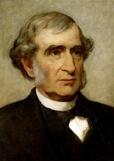One hundred and ten years after his death, Justin Morrill (1810-1898) is still winning awards.
He never attended a university, but received an honorary degree from the University of Pennsylvania in 1884. In 1999, 189 years after his death, a 55-cent postage stamp was issued with his likeness. His former home became Vermont's first historic site in 1960. Twelve university buildings, one highway and a county in Nebraska have been named after Justin Morrill. No counting the number of Justin Morrill portraits, busts and statues that crop up in hallways of institutions across America.
And on Aug. 31, Vermont native Justin Morrill was inducted into Vermont's own Agricultural Hall of Fame.
During a luncheon at the Champlain Valley Exposition in Essex, Morrill was among four champions of agriculture honored for 2008. His photo will join those of 32 farmers and leaders in government education and agriculture in the entry of the Robert E. Miller building at the fairgrounds.
Morrill was a shopkeeper, U.S. Congressman, Senator, regent of the Smithsonian Institution, University of Vermont trustee and sponsor of the 1862 Morrill Act that funded nationwide land-grant colleges whose cornerstone is agriculture. These now total 106.
"Although he was a farmer and merchant with no formal schooling beyond the age of 15, Justin Morrill clearly influenced thousands of students across the United States with his vision and his commitment to agricultural education," David Grimm, the Expo's general manager, said delivering prepared remarks.
Other 2008 inductees were: longtime Caledonia County UVM Extension agent, newspaper columnist and renowned barn designer Philip Grime of St. Johnsbury who died in December of 2007; W. Dean Merrill of Woodstock, a leader in Vermont's beef industry — particularly the Angus breed; and U.S. Sen. Patrick Leahy, whose work on the Senate agriculture committee greatly benefits Vermonters. Leahy helped pass the Northeast Dairy Compact credited with stabilizing milk prices from 1997 to 2001. His Farmland Protection program helped preserve more than 350 Vermont farms and 108,000 acres and bringing some $60 million to the state. He also sponsored the organic food production act, is active in conservation issues and use of the Internet.
Vermont Agricultural Hall of Fame began in 2003 as a project of the Vermont Farm Bureau.

The Hits Just Keep on Coming for Justin Morrill
ShareSeptember 23, 2008